Temperature Anomalies in the Northern and Southern Hemispheres: Evidence of Persistence and Trends
Abstract
This paper analyses temperature anomalies in the northern and southern hemispheres, and the differences between the two in order to estimate the time trend coefficients and the degrees of persistence in the data. Analysing the entire sample period (from 1880m1 to 2022m10), the results indicate lower degrees of persistence and more acute trends in northern hemisphere temperatures. We also observe some degree of persistence and a positive trend for the differenced series. Finally, observing the evolution of these two factors over the last 50 years, we see that in northern temperatures, both the degree of persistence and the time trend have increased over time, whereas similar increases were not observed in southern temperatures.
1. Introduction
Global warming or climate change has been an issue of growing concern for many years. According to the World Meteorological Organization [1], average global temperatures in 2022 were between 1.02 and 1.28°C higher than mean temperatures during the period 1850–1900, with the period 2015–2022 being the warmest on record.
West and Central Europe, North America, China, and other countries in the northern hemisphere have experienced severe drought and extreme heat during 2022, severely impacting crops and placing further stress on food prices [2]. Heat waves, droughts, and floods around the world are causing a great deal of human suffering and economic losses [1]. Some authors estimate that increasing CO2 emissions will cause global temperatures to rise by an average of 3.6: 4.8°C in the northern hemisphere and 2.4°C in the southern [3].
Temperature increases in the northern hemisphere appear to be more acute and continuous than in the southern hemisphere [4, 5, 6]. The difference in anomaly values between the two hemispheres is evident due to, among other things, differences in population and industrial development, the number of weather monitoring stations, and the larger surface area of oceans in the southern hemisphere, attenuating temperatures [7, 8, 9].
The aim of this study is to analyse the time series of temperature anomalies in the northern and southern hemispheres and the differences between the two to determine the magnitude of the trend coefficients, if they are statistically significant, for the period considered (1880–2022). Rather than assuming the associated errors are integrated of order 0 or short memory processes, the order of integration is estimated from a fractional point of view, i.e., the errors are integrated of order d, or I (d), where d can be any real value, including a fractional number and directly estimated from the data. Thus, if the differencing parameter d is found to be positive, the series displays long memory, as is widely observed in climatological time series [10, 11, 12, 13, 14, 15], and the estimate of the time trend would produce different and more precise results than those obtained under the assumption that d is equal to 0.
This work has two principal research objectives: First, to determine if the northern and southern hemisphere temperature anomalies series display the long memory feature observed in many climatological series. Second, if this is the case, verify if the time trend coefficients are statistically significant, supporting the hypothesis of global warming. In addition, we analyse the series corresponding to the difference between the two hemispheres to determine if these same features hold.
The results can be anticipated as follows: we observe some differences between the northern and southern hemispheres’ results. Thus, lower degrees of persistence and higher time trend coefficients are observed in the northern hemisphere, which indicates that climatic conditions are less stable and, therefore, may lead to greater climate variability with extreme weather events such as heat waves, droughts, and storms. In this series, we also observe that the persistence level has increased with time, and the positive time slope has become deeper since 1975, which translates into a more rapid increase in the average temperatures and, on the other hand, suggests that current warming trends are becoming more long-lasting. This implies that temperature anomalies will persist for longer periods, exacerbating the effects of climate change.
For the southern temperatures, the estimate of the differencing parameter d is higher than for the northern data, suggesting that temperatures in the southern hemisphere are less volatile, and the time trend only becomes significantly positive after 2010, indicating that the southern hemisphere has shown later warming than the northern hemisphere.
2. A Review of the Literature
While there is extensive literature on climate analysis [16, 17, 18, 19, 20], there is no clear consensus about how to model climatological time series. One approach is to assume that temperature time series are stationary I (0), described as short memory processes (e.g., [21]). Alternatively, unit roots or non-stationary I (1) processes can be considered [22, 23, 24, 25]. Studies, however, are inconclusive. While some authors have found a statistically significant positive trend [26, 27], others identify stochastic features that call into question human-induced climate change ([21, 22], etc.). Other alternatives include spectral analysis [28] and trendless fluctuation analysis [29, 30, 31], etc.
Studies have generally focussed on standard linear regression models over time, analysing whether the time trend coefficient is significantly positive [27, 32, 33]. The key issue here is the specification of the error term that, in most models, is based on a short memory (or I (0)) using white noise or autoregressive moving average (ARMA) models.
At present, most studies focus on the evolution of temperature, taking into account the long memory of the series; for example, Gil-Alana [34] used northern hemisphere temperature data from 1854 to 1999, finding a high degree of persistence in the series with an order of integration substantially higher than 0. In a subsequent study, Gil-Alana [35] studied global and hemispheric anomalies, again using fractional integration techniques but with segmented trends from parametric and non-parametric approaches. The study concluded that all series display long memory with statistically significant trends but with varying results depending on the series and the model being analysed. Using a non-parametric approach and assuming the existence of a single break in the data, the results show an increase of 2.37°C over the last 100 years in the northern hemisphere and 1.37°C increase in southern and global temperatures. Without breaks, the results indicate lower increases in temperature, with values ranging between 0.46 and 0.51°C over the last 100 years. A number of other studies have also analysed the effect of single or multiple breaks in temperature anomaly data [36, 37]. Climate studies have also focused on the analysis of time series of precipitation [38], relative humidity [39], pollution, and the effects of climate change [40].
3. Materials and Methods
Within this category, there are many statistical processes, including, for example, the fractional Gaussian noise model, proposed in Mandelbrot and Van Ness [41]. However, another simple model, widely used by time series analysts, is based on the concept of fractional integration or I (d) processes.
In this context, if d is a non-integer value, xt will be a function of all its past history; the higher the d value, the higher the degree of dependence between observations. Moreover, if d is positive, the series exhibits long memory for reasons explained above, and mean reversion takes place as long as d is smaller than 1, while stationarity holds if d < 0.5 (if d ≥ 0.5, the series is non-stationary and higher the d is, the higher is the non-stationary component, in the sense that the variance of the partial sums increase in magnitude with d).
- (I)
short memory or I (0), if d = 0,
- (II)
long-memory covariance stationary behaviour, if 0 < d < 0.5,
- (III)
non-stationary though mean reverting processes, if 0.5 ≤ d < 1,
- (IV)
unit roots or I (1), if d = 1, and
- (V)
explosive patterns, if d ≥ 1.
These processes were originally proposed by Granger [42, 43], Granger and Joyuex [44], and Hosking [45] based on the observation that the periodogram of many series presented at the zero frequency, a value very close to 0, consistent with non-stationarity and the need for initial differentiation. However, they also observed that the periodogram of the first differenced data was very close to 0 at the 0 frequency, which suggested over-differentiation. According to these authors, something may occur between these two (I (0) and I (1)) scenarios, which favours the appearance of fractional integration or fractional differentiation.
There are numerous different procedures for the estimation and testing of the differencing parameter d, some non-parametric, such as the Hurst exponent and the R/S statistic proposed by Hurst [46] for testing long memory (the Hurst exponent (H) is related with the differencing parameter throughout the relationship: H = d–0.5. See also Lo [47] for a modified version of this procedure.). Semiparametric classical methods are Geweke and Porter-Hudak’s [48] log-periodogram estimator of d, later improved by Robinson [49] and Kim and Phillips [50], among others. Parametric approaches include Sowell’s [51] maximum likelihood estimator and the Robinson test [52], the approach used in this work.
Robinson [52] proposed a testing procedure based on the Lagrange multiplier principle for testing the null hypothesis H0: d = d0 for any real value d0 in an I (d) framework as given in Equation (1). There are many advantages to using this procedure: it does not impose stationarity for implementation since d0 can include values outside the stationary region; it has a standard N (0,1) null and local limit distributions, which hold independently of the inclusion of deterministic terms and the modelling the I (0) error term; it is also the most efficient method in the Pitman sense against local departures from the null (see [53] for the functional form of the test statistic used in this work).
3.1. Data
Anomaly data for the northern and southern hemispheres are taken from the NOAA (National Center for Environmental Information, https://www.ncei.noaa.gov) series, the data source used extensively in global climate studies. The monthly data span from 1880 to 2022 and are the combined global land and ocean temperature anomalies, i.e., deviations from the 1901 to 2000 mean. These two series have been widely examined in previous studies on climatological change ([34, 35, 54, 55, 56, 57, 58], etc.).
Figure 1 displays the time series plots of the two series (northern and southern hemispheres) along with the range, that is, the differences between the two. We found a significant rising trend in the mid-sample around 1946, particularly for the first two series. In the case of the range, the increase appears slightly later.
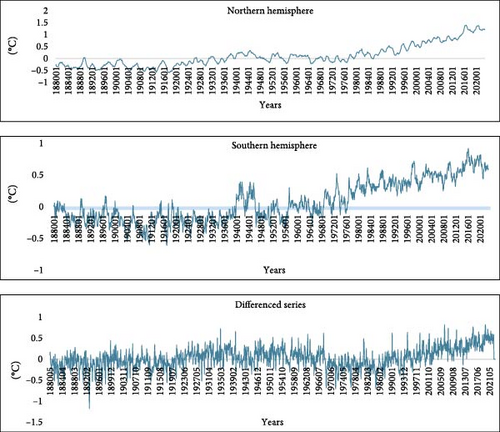
Figure 2 displays the first 100 values in the periodograms of the series. On the left are the periodograms of the three series, while those on the right correspond to the periodograms of the first differenced data. The plots on the left show a large value around the smallest (zero) frequency, which may be an indication of the need for initial differentiation. However, on the right, corresponding to the periodograms of the first differenced data, we observe values close to zero at that frequency, which may suggest that the series are now over-differenced., i.e., with no need of first differentiation. This is precisely the argument used by Granger [42] and this paper to justify the methodology employed based on fractional integration.
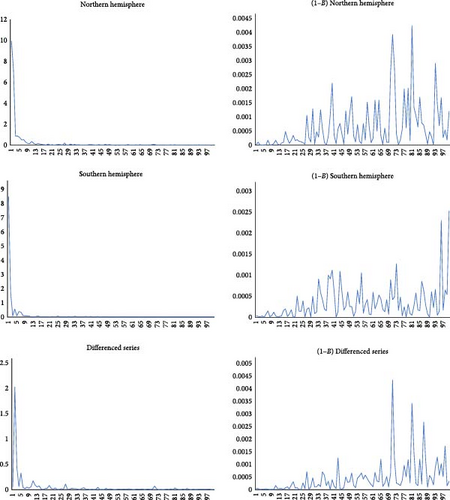
4. Empirical Results
We first estimate d for three potential set-ups depending on the specification of the constant and time trend in Equation (7). We first compute the values of d under the a priori assumption that α = β = 0; That is, we do not include deterministic terms in the model and yt = xt in the first equality in Equation (7); we then estimate d with only β = 0, so the model contains an intercept; finally, with α and β freely estimated from the data along with d, we select the correct specification across these models by the significance of the estimated coefficients using their corresponding t-values. Thus, if both coefficients are statistically significant, we choose the model with a constant and a linear time trend. However, if β is insignificant, we choose the model only with an intercept. Note here that the two first equalities in Equation (2) are jointly executed, and thus, plugging the polynomial (1–B)d in the first of them, the errors become I (0) or short memory by assumptions, justifying the use of t-values in the regression model.
Table 1 shows the coefficients in the selected specification for each series. We see that the estimates of d differ from one series to another. Thus, for northern hemisphere temperatures, the value of d is 0.46, while for the southern hemisphere, it is much higher, 0.79, implying a much higher degree of persistence in the southern temperatures. Considering the difference between the two series, d is estimated as 0.38. The confidence intervals also indicate that while stationarity holds for the northern series and the difference between the two series, southern hemisphere temperatures are clearly non-stationary, with an order of integration much higher than 0.50. By contrast, we also see that the time trend coefficient is significantly positive for northern temperatures, statistically insignificant for southern temperatures, and positive (though with a smaller magnitude than for northern temperatures) in terms of differences. The seasonal AR coefficient is almost insignificant in the three series examined.
| Series | d (95% band) | Intercept (t-value) | Time trend (t-value) | Seas. |
|---|---|---|---|---|
| Northern hemisphere | 0.46 (0.43, 0.50) | −0.32476 (−3.82) | 0.00069 (6.53) | 0.051 |
| Southern hemisphere | 0.79 (0.75, 0.83) | — | — | −0.037 |
| Differences | 0.38 (0.34, 0.42) | −0.15995 (−2.49) | 0.00024 (3.57) | 0.055 |
- The values in parenthesis in column 2 are the 95% confidence bands of the estimates of d. Columns 3 and 4 contain the t-values of the corresponding estimates. — Means lack of significance.
Table 2 shows the results with Bloomfield’s [59]-type disturbances. The estimates for d are now slightly smaller than in the previous case, although the same conclusions hold regarding the stationarity and differences of northern hemisphere temperatures and the non-stationarity of southern temperatures. The estimates of the slope coefficients, all significant, are 0.00067 for northern, 0.00038 for southern temperatures, and 0.00024 for the difference between the two series.
| Series | d (95% band) | Intercept (t-value) | Time trend (t-value) |
|---|---|---|---|
| Northern hemisphere | 0.49 (0.45, 0.54) | −0.30130 (−3.19) | 0.00067 (5.42) |
| Southern hemisphere | 0.70 (0.63, 0.79) | −0.01716 (−2.29) | 0.00038 (1.94) |
| Differences | 0.36 (0.32, 0.41) | −0.15897 (−2.69) | 0.00024 (3.92) |
In the final section, we extend the sample to incorporate the observations for the first 10 months of 2022. The results (Table 3) show very similar results to those in Table 2, with the same values for degrees of persistence and a slight increase in the slope of the time trend in the case of northern hemisphere temperatures and for the difference between the two hemispheres.
| Series | d (95% band) | Intercept (t-value) | Time trend (t-value) |
|---|---|---|---|
| Northern hemisphere | 0.49 (0.45, 0.54) | −0.30257 (−3.21) | 0.00068 (5.51) |
| Southern hemisphere | 0.70 (0.63, 0.78) | −0.01711 (−2.29) | 0.00038 (1.94) |
| Differences | 0.36 (0.32, 0.41) | −0.16133 (−2.74) | 0.00025 (4.07) |
Finally, we analyse if both the degree of persistence and the time trend coefficient have changed across the sample period. For this purpose, we re-estimate the model first with data ending at 1969m12 and then adding successive 60 observations (i.e., 5 complete years) for each subsample until the end of the sample. Results for the northern and southern temperatures, and the differences between them, are shown in Figures 3, 4, and 5, respectively. The left plots display the estimates of d (and their 95% confidence intervals), while the right plots represent the β-coefficient. The lack of values in some cases in these plots refers to statistical insignificance.
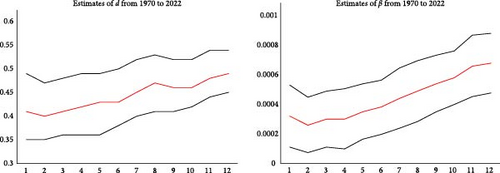
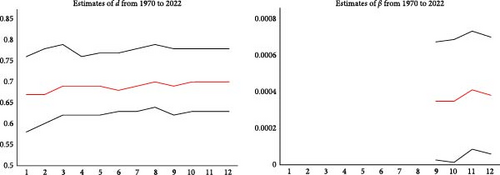
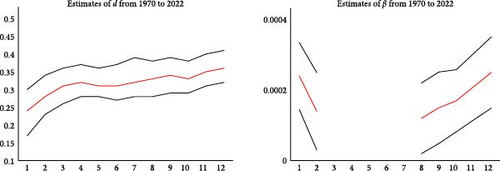
Starting with northern temperatures and focussing on d, we see a slight increase in the value of d as we increase the sample size; thus, the series seems to become more persistent over time. The same is the case in the time trend, showing a continuous increase since 1975.
For southern temperature data (Figure 4), the estimate of d has remained relatively stable over time, with an estimated d value of ~0.67, thus displaying a non-stationary pattern. The time trend coefficient is found to be statistically insignificant across most of the subsamples and only becomes significant with data ending at 2010 onwards.
Finally, for the differenced data (Figure 5), we first observe an increase in the value of the differencing parameter, moving from 0.24 (with data ending at 1969m12) to 0.36 (with data ending at 2022m10). Here, the time trend coefficient is also significant for cases with the shortest and longest subsamples.
5. Discussion
The results reported in the above section indicate substantial differences between the two hemisphere datasets. Lower degrees of persistence and more accentuated trends are observed in the northern hemisphere, where a slight increase in d is observed as we increase the sample size; that is, the series becomes more persistent over time, with the time trend coefficient being significantly positive and showing a continuous increase since 1975 in line with Shi et al. [61], which analyses temperatures in the northern hemisphere over the last 2000 years and Schlosser et al. [62], which reconstructs northern hemisphere annual temperatures since 1671 showing trends and persistence patterns. For the southern hemisphere, the estimate of d has remained relatively stable over time, showing a non-stationary pattern (values significantly above 0.5), with the time trend coefficient being statistically insignificant in most cases (it only becomes significant from 2010 onwards). By contrast, for the differenced series, we observe some evidence of stationary long memory, with an order of integration of ~0.36 and a significant positive time trend, although with a more moderate slope than in northern temperatures. Though not reported, almost identical results were obtained when using other parametric [51] or even semiparametric [63] methods when estimating the differencing parameter d, obtaining evidence of values in the interval (0, 1). These results contradict partially those papers that argue in favour of the presence of unit roots in temperature data (e.g., [24, 25]); however, it makes sense if we take into account that unit root procedure, in general, how very low power if the data are in fact fractionally integrated (see, e.g., [64, 65, 66]).
Our results suggest that, given the heterogeneity in terms of trend and persistence patterns in the temperature anomalies of both hemispheres, the policies adopted by governments to mitigate climate change should be oriented towards identifying the causes of the differences observed in the anomaly series such as the distribution of continental and oceanic masses [67], ocean currents and their influence on heat distribution [68], cyclonic activity [69], or topographic differences between hemispheres [70] and thus enable from precise and effective climate action. For example, in the event of an exogenous shock affecting temperatures, the recovery will be faster in the northern hemisphere than in the southern one, requiring stronger policy actions in the southern hemisphere to recover the original trends.
The persistence in temperature changes suggests that the northern hemisphere has a greater sensitivity to climate forcing factors, both natural and anthropogenic, which can have significant regional impacts affecting weather patterns (heat waves, cyclones, droughts) with consequences for agriculture, infrastructure, ecosystems, among others. Therefore, climate modelling must take into account the analysis of persistence so that future projections and environmental policies can be better geared to the fight against climate change. On the other hand, the differences between persistence and temperature trends in the hemispheres highlight the uneven climate change, which has implications for global climate policies.
6. Conclusions
In this paper, we have analysed northern and southern hemisphere temperature anomalies along with the difference between them in the series corresponding to the time period 1880m1 to 2022m10 using long memory processes and, in particular, a fractionally integrated modelling approach. Using this framework, we can determine the degree of persistence of the data and examine the existence of time trends from a more general and flexible view than with classical methods based on ARMA (for stationary) and ARIMA (for non-stationary) processes.
The results show substantial differences between the northern and southern hemisphere temperature data, observing lower degrees of persistence and higher time trends in the northern case. Thus, a question that emerges from these results is to understand the underlying drivers of this difference between the degrees of persistence in the two hemispheres. In this context, a fine-scale analysis can be conducted to offer valuable insights into localised climate dynamics. Future research should also incorporate potential non-linearities and structural breaks in the data. These two issues are closely related to the long memory property observed in the data ([71, 72, 73, 74], etc.), and failing to take them into account may affect the estimates of the time trends in the data.
Disclosure
A preprint of this manuscript has previously been published in Gil-Alana and Carmona-González [75].
Conflicts of Interest
There are no conflicts of interest with the publication of the present manuscript.
Acknowledgments
Prof. Luis A. Gil-Alana gratefully acknowledges financial support from the MINEIC-AEI-FEDER ECO2017-85503-R project from “Ministerio de Economía, Industria y Competitividad” (MINEIC), “Agencia Estatal de Investigación” (AEI) Spain, and “Fondo Europeo de Desarrollo Regional” (FEDER). He also acknowledges support from an internal project of the Universidad Francisco de Vitoria.
Open Research
Data Availability
The data that support the findings of this study are available from the corresponding author upon reasonable request.




